When visual effects supervisor Roger Guyett got the call to begin work on J.J. Abrams’ Star Wars: The Rise of Skywalker, the project was early in pre-production with two prominent challenges which would be unlike any in a previous Star Wars film. “The scene when Rey and Ren are fighting is a big water scene,” said Guyett of the first major task. “That gave us an opportunity to think about the technology we were going to use for that. The other thing was Leia: [Abrams] wanted to include Leia, and we talked about different options about how we might go about it.”
Both Guyett and Abrams agreed that Leia would somehow be played by Carrie Fisher who had passed away prior to principal photography. “You don’t want to do a thing where you’re authoring her performance through someone else, if you’d done motion capture or used someone else,” Guyett explained, noting that many different techniques combined to place Carrie Fisher into Leia’s notable scenes in the film. “J.J. wanted to make sure her performance had integrity to it, and, then, how do you go about putting that into the movie?”
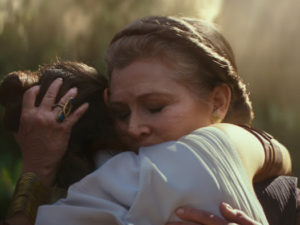
With two important hurdles to overcome, Guyett went into The Rise of Skywalker with equal parts enthusiasm and optimism. “The great thing about Star Wars, for me, and I think we all feel the way, is it’s such a fabulous collaboration between all departments,” Guyett described, “whether it’s [practical] special effects [supervised by Dominic Tuohy] and us figuring out how to do the speeder chase, or Neal [Scanlan, practical creature effects] and I talking about Palpatine and what we need to do.”
Further invoking the sense of collaborative work on a Star Wars film, Guyett spoke of how the franchise originator, George Lucas, executed his vision on the initial 1977 Star Wars film without the advent of advanced computer graphics. “It’s all about the image,” Guyett noted, “and using all those resources, all those departments—costume and special effects and visual effects—try to make it about the image on the screen. I think about the spirit of those old movies, where they, practically, tried to shoot everything; they had no choice. If they wanted to go to a different planet, they had to go to Tunisia. You’re trying to convince the audience that all of this is happening, however crazy sometimes it might feel. As an audience member, you want to be immersed in that world and feel like it’s incredibly real, and that you’re taking an audience on that journey.”
For Tuohy, the experience on The Rise of Skywalker, his first film with Abrams, was one which utilized his facility for creating practical on-set effects that go directly to camera. “When you start to read the script and go into meetings [with Abrams], he really does want to get interaction as much as possible on the day of,” Tuohy said of his practical special effects, differentiated from visual effects, which are largely executed in post-production. “Then, because Roger’s worked with J.J. before, there’s this expectation: ‘Dom you’re going to do something here,’ and that’s when it gets interesting. You’re trying to keep the DNA of Star Wars and that history of being practical, but knowing you want to take it to the next level and up the ante a little bit more—make it modern, but not come out of the history of Star Wars. We want to pay homage to that and make something quite special. J.J. doesn’t actually tell you what he wants, as in ‘I want water cannons here.’ He says, ‘Dom, this is the set. Make it work.’”
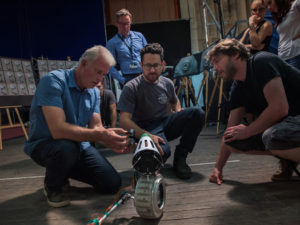
When shooting the aforementioned light saber fight which Rey and Kylo Ren have on a pier, which involved huge waves crashing around them, it was important to Abrams, Guyett, and Tuohy to film as much of the scene as possible on a practical set with live water elements. “We did it at a miserable time of year for the actors,” Guyett revealed. “It was freezing cold, [with] something like a hundred thousands gallons of water a day being fired at them, and the truth is you don’t have to do all of that. We could have had less water, but the truth is, it puts those actors in that place; they really are, no matter how far-fetched it is, fighting in a raging ocean.”
Even though the reality of the mechanics required for Tuohy’s team to blast water at the long platform Rey and Ren stood upon meant that the effect would render differently from that of real oceanic waves, it was important to the team to create a practical water-based environment. “We’re doing it,” Guyett conveyed, “because we want to create the ambience of that fight.”
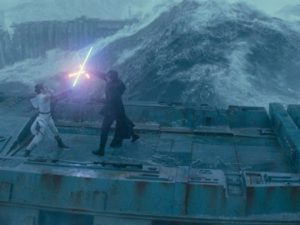
Similarly, production went to Jordan to shoot the land speeder chase midway into the film. “We shot the green screens for the speeder chase in the desert,” Guyett recalled, noting that the land speeders, actors, and backgrounds were later composited together digitally to create the final shots for the scene.
While the main shooting company filmed necessary elements in Jordan, visual effects artists photographed desert locations featured in the story’s plot points and gathered materials Guyett knew would be critical in post-production. “It’s all about the light. Dom and his team were shooting that, and a lot of people asked, ‘Why don’t you do that on a stage?’ It’s not going to feel like you’re in Jordan if you shoot that on a stage—that’s why we did that there. One of the reasons we spent so much time out there, analyzing the environment, getting all that data, is when you watch that movie, it feels like they’re riding speeders in Jordan.”
As much as the filmmakers tried to shoot practical visuals for The Rise of Skywalker, they knew there would be parts of the film that called for virtual cameras in the scene. “How do we rebuild a scene in a virtual environment?” Guyett wondered about several of the film’s effects-intensive sequences. “All of the speeder backgrounds are digital when [Rey] takes down the Tie Fighter—I don’t think many people think that’s true, it looks so photorealistic. People like Pat [Tubach, visual effects supervisor at Industrial Light and Magic] and his team go around analyzing and scanning photos from the desert, so you can recreate them.”
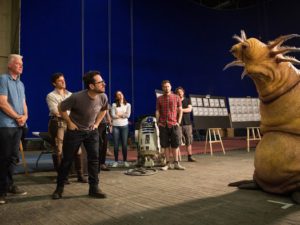
For Tuohy, his practical effects team was up to 80 people on the project, split between Jordan, the United Kingdom, and locations out of the British-based studios. “One day you’re in London at Pinewood Studios,” Tuohy said. “The next day you’re in Jordan, and we knew that we had a limited amount of time there. When we went to the Black Sands, we shot that in a day, and that’s all practical effects, with six actors going down through the floor, then reset and go again; it’s all about the light. The one thing I think is beautiful is that natural light you get when you go to places like Jordan that you can’t replicate on a stage. The pressure is to get it shot, so you’re not coming back to the U.K. trying to match something—you’re doing as much as you can there and then.”
As with other Star Wars films, visual effects company Industrial Light and Magic (ILM), formed in May of 1975 to create effects for the original Star Wars film, handled the majority of the myriad post-production effects for The Rise of Skywalker. An international firm at present, ILM employed all of its offices to work on the film. Supervised by Patrick Tubach, the overall ILM visual effects supervisor, a group of crafts teams in Singapore were responsible for the described water scene; ILM in Vancouver toiled on shots set in the Sith Sanctuary.
ILM’s headquaters in San Francisco covered the Battle over Exegol while a new Australian ILM office handled stunt work and compositing. Other companies created additional effects, including Important Looking Pirates, Hybride Technologies, and Base Effects—over 2000 technicians and artists created the film’s visual effects.
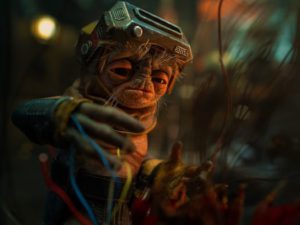
Lastly, it was Neal Scanlan’s responsibility to produce practical creature effects to be photographed live on set with the actors and constructed sets. “We’ve never made so many creatures for a film than what you see in this film,” said Scanlan about his British team, numbering 200. “The great thing about Star Wars and the world George set up is the effects—in its day—were ground-breaking and breathtaking, as they are in this film now. But there’s also an abstract of a world in which I think theatre plays a role. When we approach practical effects or animatronics, we’re not trying to make them photorealistic; we’re not trying to challenge that. We’re trying to give the audience a moment to enjoy. When you looked at Yoda in the old films and you heard Frank [Oz, puppeteer]’s voice, you knew that was a puppet, and engaged with it, and became enthralled by what Frank was doing. We tried to do the same with little moments in this film.”
For Scanlan, it was critical for him to produce practical creatures familiar to fans of the original Star Wars trilogy (1977-1983). “We tried to let the audience get their full dose of their beloved franchise,” he commented. “It would be a shame or a dishonor to the Star Wars tradition. Obviously, digitally, it’s amazing because we can do things we’ve always wanted to do, without ILM having to remove puppeteers or even enhance in areas. But it is absolutely a conscious decision and a very important thing to all of us to maintain what we believe is a crucial blend of cutting edge digital effects with, in a sense, pure wonderful theatre we’ve all grown up with.”
In closing, Guyett pointed to the success of Abrams’ tenure in the cinematic world of Star Wars. “JJ. is incredibly passionate about Star Wars,” Guyett said. “He’s incredibly motivational in the sense of his enthusiasm, and his energy is infectious. It’s an incredibly complicated movie to make on a massive scale, but his leadership is incredible.”





